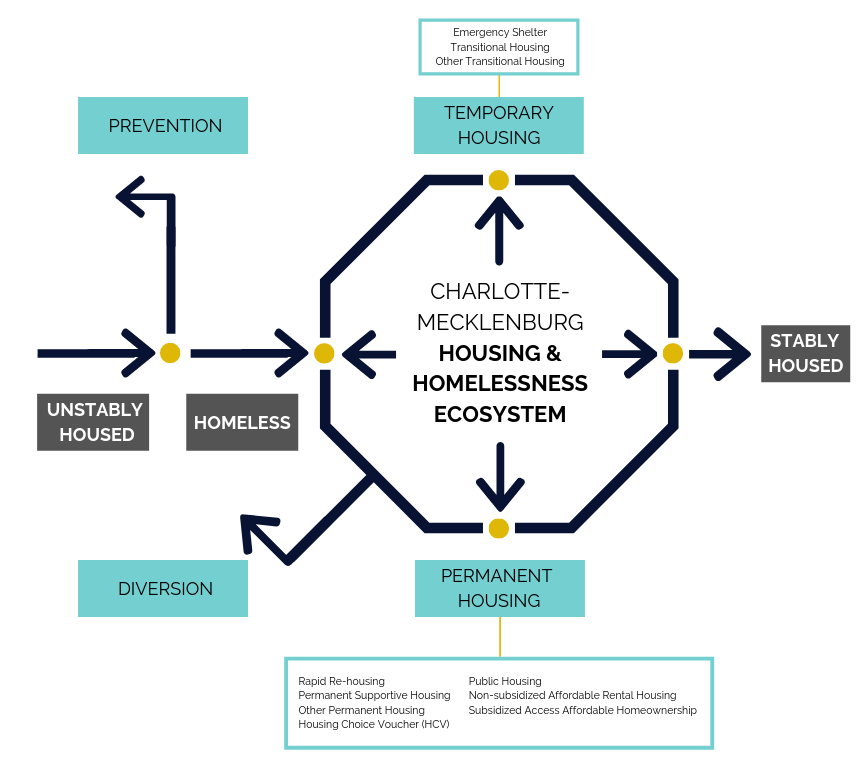Courtney Morton
Mecklenburg County Community Support Services
Bridget Anderson
UNC Charlotte Urban Institute
Mecklenburg County Community Support Services (CSS), in partnership with UNC Charlotte Urban Institute, releases today (September 12, via the Dashboard) the Housing & Homelessness Ecosystem of community providers in Charlotte-Mecklenburg.
The Ecosystem is one part of a multi-step process in creating a culture of continuous improvement. To read more about why an Ecosystem matters for Charlotte-Mecklenburg, and about how definitions are organized, check out the last two blog posts on the Building Bridges Blog.
This week’s blog post highlights the main components of the Ecosystem and suggests ways to use the information. The Ecosystem is not a static document; rather it is a dynamic site contained within the Dashboard that will be updated annually. To go to the Ecosystem, click here.
SYSTEM VIEW
The Ecosystem allows the community to see the full housing and homelessness system as well as the separate parts and how they relate to each other. Arrows depict the flow into and out of the four main categories of housing interventions: prevention, diversion, temporary housing, and permanent housing. Together, these interventions address housing instability and homelessness. An effective and efficient system must consider prevention assistance in relationship to other housing interventions, like permanent housing, and vice versa. Determining the “right” number of emergency shelter beds in a community must be viewed within the larger context of the system.
“Unstably housed,” “homeless,” and “stably housed” are terms used to describe housing states. They are included on the Ecosystem diagram relative to the category of housing interventions targeting them. For example, prevention is connected to housing instability. However, it is important to note that this is not a linear process. A household may teeter on the edge of housing instability and homelessness for a long time; and some households who move from homelessness to housing stability may return one or even multiple times. Seeing the full system allows the community to better understand such patterns and identify areas for intervention. To download and print the Ecosystem Diagram with terms and definitions on the back, please click here.
ORGANIZATIONS & SEARCHABLE TABLE
The Ecosystem has specific pages for each housing and homeless service organization in Charlotte-Mecklenburg; the information is displayed via Tableau. (To read more about the process to develop the Ecosystem click here; to learn how to add your organization, click here.) To view organization information in the Ecosystem, there are two options: “Organizations” and “Searchable Table.”
The “Organization” pages provide basic information about each organization; details capacity in terms of beds or units for those providing temporary or permanent housing; and indicates the funding category for each housing intervention. The number of units and beds is a snapshot of community capacity for the period around January 2019, in alignment with the timeline of the Housing Inventory Count. It is important to note that the capacity inventory is currently a snapshot, which is an undercount of all available and planned capacity.
The “Searchable Table” page provides data about organizations, housing types, populations served, Coordinated Entry/NC 2-1-1 status, and funding categories in a format that allows data to be easily examined and compared across categories.
SO, WHAT
The Ecosystem represents an important step for Charlotte-Mecklenburg to address housing instability and homelessness as a system. All organizations that provide housing interventions across the continuum are included, regardless of funding source or homelessness definition used. And, each year, the Ecosystem will expand with new information and organizations.
When everyone and everything is depicted in one place, the community can see how and to what extent resources are allocated; and identify opportunities for positive change.
Just as the organizations and housing categories within the Ecosystem must be viewed in relationship to each other, the Housing & Homelessness Ecosystem must be understood in relationship to other systems. A household’s ability to access and sustain housing is also impacted by access to affordable childcare, transportation, and healthcare. Coordination and collaboration across systems is critical to ensure proper alignment and targeting of all resources.
You can help simply by using the Ecosystem. Below are options for consideration:
- Align terms and definitions in your organization with definitions in the Ecosystem. Alignment depends upon defining and describing the housing and homelessness system as a system.
- Learn the Ecosystem. Start by finding your organization, and looking for other organizations that provide the same category of housing intervention. If you are not already, are there opportunities for you to collaborate with these organizations? What categories of funding exist for your category of housing intervention? Do all organizations partner with Coordinated Entry/NC 2-1-1? (Coordinated Entry is Charlotte-Mecklenburg’s portal to connect individuals and families who are experiencing homelessness or housing instability to an existing available shelter or housing resource. Coordinated Entry also helps the community to prioritize resources for the most vulnerable households and to identify gaps and shortages in housing resources.) Once you have looked at organizations in your own housing category, feel free to repeat this process with other housing categories.
Courtney Morton coordinates posts on the Building Bridges Blog. Courtney is the Housing & Homelessness Research Coordinator for Mecklenburg County Community Support Services. Courtney’s job is to connect data on housing instability, homelessness and affordable housing with stakeholders in the community so that they can use it to drive policy-making, funding allocation and programmatic change.
Bridget Anderson is a Social Research Specialist at the UNC Charlotte Urban Institute. She works to provide data insights for community issues relating to homelessness, public health, and social capital.


